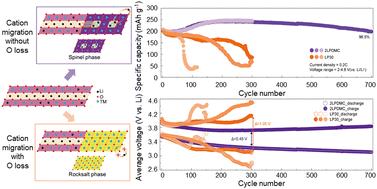当前位置:
X-MOL 学术
›
Energy Environ. Sci.
›
论文详情
Our official English website, www.x-mol.net, welcomes your
feedback! (Note: you will need to create a separate account there.)
Decoupling capacity fade and voltage decay of Li-rich Mn-rich cathodes by tailoring surface reconstruction pathways
Energy & Environmental Science ( IF 32.4 ) Pub Date : 2024-11-12 , DOI: 10.1039/d4ee02329c Gukhyun Lim, Min Kyung Cho, Jaewon Choi, Ke-Jin Zhou, Dongki Shin, Seungyun Jeon, Minhyung Kwon, A-Re Jeon, Jinkwan Choi, Seok Su Sohn, Minah Lee, Jihyun Hong
Energy & Environmental Science ( IF 32.4 ) Pub Date : 2024-11-12 , DOI: 10.1039/d4ee02329c Gukhyun Lim, Min Kyung Cho, Jaewon Choi, Ke-Jin Zhou, Dongki Shin, Seungyun Jeon, Minhyung Kwon, A-Re Jeon, Jinkwan Choi, Seok Su Sohn, Minah Lee, Jihyun Hong

|
Exploiting oxygen anion redox in Li-/Mn-rich layered oxides (LMR-NMCs) offers the highest capacity among cathode materials for Li-ion batteries (LIBs). However, its long-term utilization is challenging due to continuous voltage and capacity decay caused by irreversible phase transitions involving cation disordering and oxygen release. While extensive studies have revealed the thermodynamic origin of cation disordering, the mechanisms of oxygen loss and consequent lattice densification remain elusive. Moreover, mixed spinel-rocksalt nanodomains formed after cycling complicate the degradation mechanism. Herein, we reveal a strong correlation between phase transition pathways and oxygen stability at the particle surface in LMR-NMCs through a comparative study using electrolyte modification. By tailoring surface reconstruction pathways, we control the overall phase and electrochemistry evolution mechanisms. Removing polar ethylene carbonate from the electrolyte significantly suppresses irreversible oxygen loss at the cathode–electrolyte interface, preferentially promoting the in situ layered-to-spinel phase transition while avoiding typical rocksalt phase formation. The in situ formed spinel-stabilized surface enhances charge transfer kinetics through three-dimensional ion channels, maintaining reversible Ni, Mn, and O redox capability over 700 cycles, as revealed by electron microscopy, X-ray absorption spectroscopy, and resonant inelastic X-ray scattering. Deep delithiation and lithiation enabled by the surface spinel phase accelerate the bulk layered-to-spinel phase transition, inducing thermodynamic voltage fade without capacity loss. Conversely, conventional electrolytes induce layered-to-rocksalt surface reconstruction, impeding charge transfer reactions, which causes simultaneous capacity and (apparent) voltage fades. Our work decouples thermodynamic and kinetic aspects of voltage decay in LMR-NMCs, establishing the correlation between surface reconstruction, bulk phase transition, and the electrochemistry of high-capacity cathodes that exploit cation and anion redox couples. This study highlights the significance of electrochemical interface stabilization for advancing Mn-rich cathode chemistries in future LIBs.
中文翻译:

通过定制表面重建路径对富锂富锰阴极的去耦容量衰减和电压衰减
在富含锂/锰的层状氧化物 (LMR-NMC) 中利用氧阴离子氧化还原,为锂离子电池 (LIB) 提供了最高的正极材料容量。然而,由于涉及阳离子无序和氧释放的不可逆相变会导致持续的电压和容量衰减,因此其长期使用具有挑战性。虽然广泛的研究揭示了阳离子无序的热力学起源,但氧损失和随之而来的晶格致密化的机制仍然难以捉摸。此外,循环后形成的混合尖晶石-岩盐纳米域使降解机制复杂化。在此,我们通过使用电解质改性的比较研究揭示了 LMR-NMCs 中颗粒表面的相变途径与氧稳定性之间的强相关性。通过定制表面重建途径,我们控制整体相和电化学演化机制。从电解质中去除极性碳酸乙烯酯可显著抑制阴极-电解质界面处不可逆的氧损失,优先促进原位分层到尖晶石的相变,同时避免典型的岩盐相形成。正如电子显微镜、X 射线吸收光谱和共振非弹性 X 射线散射所揭示的那样,原位形成的尖晶石稳定表面增强了通过三维离子通道的电荷转移动力学,在 700 次循环中保持可逆的 Ni、Mn 和 O 氧化还原能力。表面尖晶石相实现的深度脱锂和锂化加速了体层状到尖晶石的相变,诱导热力学电压衰落而不会造成容量损失。 相反,传统电解质会诱导层状到岩盐表面重建,阻碍电荷转移反应,从而导致同时容量和(明显的)电压衰减。我们的工作将 LMR-NMC 中电压衰减的热力学和动力学方面解耦,建立了表面重构、体相变以及利用阳离子和阴离子氧化还原对的高容量阴极的电化学之间的相关性。本研究强调了电化学界面稳定对于在未来 LIB 中推进富含 Mn 的阴极化学的重要性。
更新日期:2024-11-12
中文翻译:

通过定制表面重建路径对富锂富锰阴极的去耦容量衰减和电压衰减
在富含锂/锰的层状氧化物 (LMR-NMC) 中利用氧阴离子氧化还原,为锂离子电池 (LIB) 提供了最高的正极材料容量。然而,由于涉及阳离子无序和氧释放的不可逆相变会导致持续的电压和容量衰减,因此其长期使用具有挑战性。虽然广泛的研究揭示了阳离子无序的热力学起源,但氧损失和随之而来的晶格致密化的机制仍然难以捉摸。此外,循环后形成的混合尖晶石-岩盐纳米域使降解机制复杂化。在此,我们通过使用电解质改性的比较研究揭示了 LMR-NMCs 中颗粒表面的相变途径与氧稳定性之间的强相关性。通过定制表面重建途径,我们控制整体相和电化学演化机制。从电解质中去除极性碳酸乙烯酯可显著抑制阴极-电解质界面处不可逆的氧损失,优先促进原位分层到尖晶石的相变,同时避免典型的岩盐相形成。正如电子显微镜、X 射线吸收光谱和共振非弹性 X 射线散射所揭示的那样,原位形成的尖晶石稳定表面增强了通过三维离子通道的电荷转移动力学,在 700 次循环中保持可逆的 Ni、Mn 和 O 氧化还原能力。表面尖晶石相实现的深度脱锂和锂化加速了体层状到尖晶石的相变,诱导热力学电压衰落而不会造成容量损失。 相反,传统电解质会诱导层状到岩盐表面重建,阻碍电荷转移反应,从而导致同时容量和(明显的)电压衰减。我们的工作将 LMR-NMC 中电压衰减的热力学和动力学方面解耦,建立了表面重构、体相变以及利用阳离子和阴离子氧化还原对的高容量阴极的电化学之间的相关性。本研究强调了电化学界面稳定对于在未来 LIB 中推进富含 Mn 的阴极化学的重要性。


















































 京公网安备 11010802027423号
京公网安备 11010802027423号